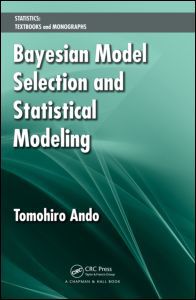 There is this book Bayesian Model Selection and Statistical Modeling by Tomohiro Ando, which I reviewed on my blog eight years ago. To quote from the main paragraph, "What I consider to be innovative or at least “novel” parts with comparison with existing books (like Chen, Shao and Ibrahim, 2000, which remains a reference on this topic) is based on papers written by the author over the past five years and it is mostly a sort of asymptotic Bayes analysis that I do not see as particularly Bayesian, because involving the “true” distribution of the data. The coverage of the existing literature on Bayesian model choice is often incomplete and sometimes misses the point. This is especially true for the computational aspects that are generally mistreated or at least not treated in a way from which a newcomer to the field would benefit. The author often takes complex econometric examples for illustration, which is nice; however, he does not pursue the details far enough for the reader to be able to replicate the study without further reading."
There is this book Bayesian Model Selection and Statistical Modeling by Tomohiro Ando, which I reviewed on my blog eight years ago. To quote from the main paragraph, "What I consider to be innovative or at least “novel” parts with comparison with existing books (like Chen, Shao and Ibrahim, 2000, which remains a reference on this topic) is based on papers written by the author over the past five years and it is mostly a sort of asymptotic Bayes analysis that I do not see as particularly Bayesian, because involving the “true” distribution of the data. The coverage of the existing literature on Bayesian model choice is often incomplete and sometimes misses the point. This is especially true for the computational aspects that are generally mistreated or at least not treated in a way from which a newcomer to the field would benefit. The author often takes complex econometric examples for illustration, which is nice; however, he does not pursue the details far enough for the reader to be able to replicate the study without further reading."
 Bayesian Data Analysis by A. Gelman et al. (2014) also contains a wealth of material on the topic. Here are my comments on that topic of model assessment: "Part II is about “the creative choices that are required, first to set up a Bayesian model in a complex problem, then to perform the model checking and confidence building that is typically necessary to make posterior inferences scientifically defensible” (p.139). It is certainly one of the strengths of the book that it allows for a critical look at models and tools that are rarely discussed in more theoretical Bayesian books. As detailed in my earlier post on Chapter 6, model checking is strongly advocated, via posterior predictive checks and… posterior predictive p-values, which are at best empirical indicators that something could be wrong, definitely not that everything’s allright! Chapter 7 is the model comparison equivalent of Chapter 6, starting with the predictive density (aka the evidence or the marginal likelihood), but completely bypassing the Bayes factor for information criteria like the Watanabe-Akaike or widely available information criterion (WAIC), and advocating cross-validation, which is empirically satisfying but formally hard to integrate within a full Bayesian perspective. Chapter 8 is about data collection, sample surveys, randomization and related topics, another entry that is missing from most Bayesian textbooks, maybe not that surprising given the research topics of some of the authors. And Chapter 9 is the symmetric in that it focus on the post-modelling step of decision making."
Bayesian Data Analysis by A. Gelman et al. (2014) also contains a wealth of material on the topic. Here are my comments on that topic of model assessment: "Part II is about “the creative choices that are required, first to set up a Bayesian model in a complex problem, then to perform the model checking and confidence building that is typically necessary to make posterior inferences scientifically defensible” (p.139). It is certainly one of the strengths of the book that it allows for a critical look at models and tools that are rarely discussed in more theoretical Bayesian books. As detailed in my earlier post on Chapter 6, model checking is strongly advocated, via posterior predictive checks and… posterior predictive p-values, which are at best empirical indicators that something could be wrong, definitely not that everything’s allright! Chapter 7 is the model comparison equivalent of Chapter 6, starting with the predictive density (aka the evidence or the marginal likelihood), but completely bypassing the Bayes factor for information criteria like the Watanabe-Akaike or widely available information criterion (WAIC), and advocating cross-validation, which is empirically satisfying but formally hard to integrate within a full Bayesian perspective. Chapter 8 is about data collection, sample surveys, randomization and related topics, another entry that is missing from most Bayesian textbooks, maybe not that surprising given the research topics of some of the authors. And Chapter 9 is the symmetric in that it focus on the post-modelling step of decision making."


